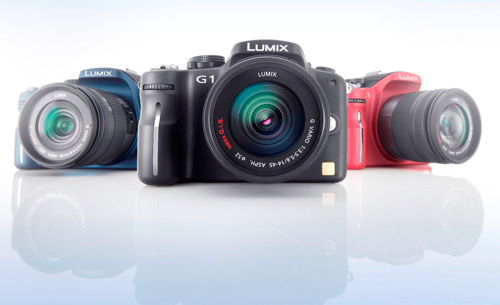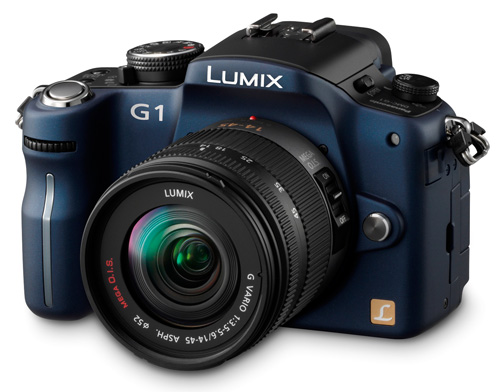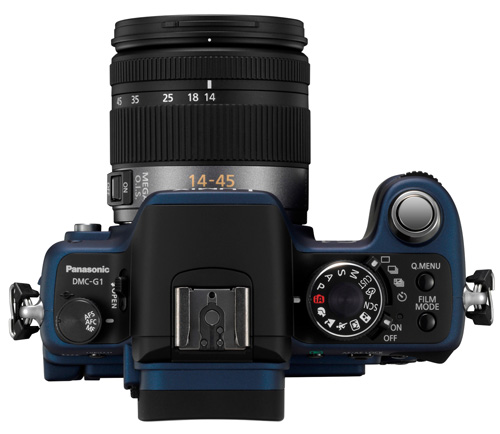Panasonic Announces G1 Micro Four-Thirds Pricing
by Wesley Fink on October 16, 2008 11:20 AM EST- Posted in
- What's New with Wes
PANASONIC PRESS RELEASE
PANASONIC ANNOUNCES PRICING FOR LUMIX DMC-G1, THE WORLD’S FIRST MICRO FOUR THIRDS SYSTEM CAMERA
PANASONIC ANNOUNCES PRICING FOR LUMIX DMC-G1, THE WORLD’S FIRST MICRO FOUR THIRDS SYSTEM CAMERA

Secaucus, NJ (October 16, 2008) – Panasonic today announced pricing for the world’s first Micro Four Thirds System camera, the LUMIX DMC-G1 – available in mid-November for a suggested retail price of $799.95, which includes the LUMIX G VARIO 14-45mm/F3.5-5.6 ASPH/MEGA O.I.S. kit lens. Also available in November, the LUMIX G VARIO 45-200mm/F4.0-5.6/MEGA O.I.S. telephoto Micro Four Thirds lens has a suggested retail price of $349.95.
The LUMIX G1, available in black, blue and red models, is the first interchangeable lens camera to offer consumers a choice of colors. Weighing about half as much as a standard digital single-lens reflex (DSLR) camera (1.28 lbs for the compact Panasonic L-10 DSLR), the LUMIX G1 is loaded with features that both entry-level and more experienced DSLR users will appreciate. The LUMIX G1 introduces a new Contrast AF (Auto Focus) system that is accurate and fast. Additionally, the LUMIX G1 features Panasonic’s Intelligent Auto mode found across the LUMIX line of cameras, which includes AF Tracking, Intelligent Exposure, MEGA O.I.S., Intelligent ISO, Intelligent Scene Selector, and Face Detection.
“The LUMIX G1 provides the power of a DSLR with many of the easy-to-use features from our point-and-shoot digital cameras,” said David Briganti, National Marketing Manager, Imaging, Panasonic Consumer Electronics Company. “With the LUMIX G1, we’re able to provide manual controls and professional-quality images, while also making the camera much more compact and with intuitive features easy for those new to DSLRs to learn and use.”


The LUMIX G1’s electronic Live View Finder, with a high-resolution 1,440,000-dot equivalent, allows the user to shoot the exact image seen, while also displaying information about the camera’s settings. The LUMIX G1 also features a free angle 3.0-inch LCD, enabling the user to see the adjustments as they are being made, a valuable learning tool for users new to manual controls, as the effects can be confirmed visually before snapping the shot.
Panasonic will expand its Micro Four Thirds System cameras and lenses in 2009, including a new model that builds on the LUMIX G1’s portability and style, while incorporating High Definition video capabilities. More details to be released in 2009. For more information about the Panasonic LUMIX DMC-G1, please visit www.panasonic.com/dsc.










13 Comments
View All Comments
computerfarmer - Wednesday, October 29, 2008 - link
I have seen full size samples at the following websitehttp://www.imaging-resource.com/PRODS/DMCG1/DMCG1A...">http://www.imaging-resource.com/PRODS/DMCG1/DMCG1A...
This Camera style is aimed at people like myself. My first digital camera was a 2mp Fujifilm FinePix A201 and the I moved to a 5mp
Fujifilm FinePix E550 and now I have a 7mp Panasonic Lumix DMC-FZ8.
I am looking for a camera both my wife and I can use. I like experimenting and she likes automatic. Many of the major brands have entry level DSLR's that would fit our needs. I am interested in good quality. The 4/3" sensor is so much larger than the sensor on the FZ-8, at least 5x larger. I do not care if this is called a DSLR or not, my interests are in quality compared to what I have been getting from my FZ-8. My camera is now in Afghanistan with my son while serving(2nd tour) with the Canadian Military.
The G1 is another good choice for me to move up to.
My wife likes the choice of colours.
Pneumothorax - Thursday, October 16, 2008 - link
These panny's although are smaller, aren't that much smaller than low end bodies like the Nikon D60/Canon rebel xsi/especially the Oly-420. I wish they really thought "outside the box" as they're no longer constrained by a pentaprism/mirror box. This camera should be alot thinner and smaller.Voldenuit - Thursday, October 16, 2008 - link
Olympus is readying a Micro 4/3 camera in a rangefinder-style body.This should be smaller than the G1.
Let's not forget, though, that the advantage of a smaller mount and no need for retrofocus means that the lenses for micro 4/3 will also be smaller than for conventional DSLRs (and even regular 4/3).
That said, I 'm waiting for the version with HD video capability.
strikeback03 - Friday, October 17, 2008 - link
Wide lenses will still be retrofocal - the registration distance of the micro 4/3 standard is 20mm. Any lenses wider than that (such as this kit 14-45) will still be retrofocal designs. So they won't have to try to make 7mm lenses with a ~40mm registration distance as they do with normal 4/3, but the wides will still be retrofocal.LtPage1 - Thursday, October 16, 2008 - link
So is this a DSLR or not? If it's not, what do SLRs have that this doesn't?ElFenix - Saturday, October 18, 2008 - link
it's not an SLR. SLRs, like all reflex cameras, have a mirror in them that bounces the light up onto the focusing screen so that you can see it through the viewfinder.this has no mirror, so is not an SLR. this is an EVIL (electronic viewfinder, interchangable lens) camera.
Wesley Fink - Thursday, October 16, 2008 - link
Micro 4/3 cameras do not have a mirror box, which means they can be much thinner and smaller with a 10mm mount to sensor distance instead of the 20mm common in real DSLR cameras. As a result of no mirror the micro 4/3 viewfinder is Live View on the LCD and/or an electronic viewfinder. Real DSLR cameras have an optical view through the lens made possible by the flipping mirror.For more information on the G1 and the new Micro 4/3 standard you can check out our earlier info on "What is Micro 4/3?" in the G1 announcement at http://www.anandtech.com/digitalcameras/showdoc.as...">http://www.anandtech.com/digitalcameras/showdoc.as....
melgross - Thursday, October 16, 2008 - link
I was expecting this to go for about $599. This is more like a bridge camera, as has been mentioned. For that purpose, it costs too much.Wesley Fink - Thursday, October 16, 2008 - link
With a collection of interchangeable micro 4/3 lenses and a sensor size close to APS C, I don't really consider the G1 a bridge camera. It's more like a different, and much smaller, approach to a Digital SLR.Having said that I do agree, however, that it is priced too high if $799 is the actual street price. Keep in mind that Panasonic MSRPs on their current DSLR cameras are MUCH higher than their actual price. If the G1 sella for a real street price of around $499 to $599 I think it will do well.
melgross - Friday, October 17, 2008 - link
Remember Olympus's old line of Pen F's? The half frame cameras? I had one, along with my Canon SLR's.Cute camera. Took decent pictures. Smaller, lighter, good, but not great pictures. Less expensive. It was also a bridge camera, like this one is. I know you protest, but it's all there.
Look at the colors for a start. That's not for the SLR crowd. It's for the point and shoot crowd. To make them feel more comfortable about the cameras. To make the cameras feel less formidable.
These will be smaller lenses as well, and less expensive, as we already see. They will be consumer lenses. Vacation lenses, family picture day lenses, Bowser the dog picture lenses, watch the baby walk lenses.
I think a list for this of $599 would have been better, and a street price in the low $400's.
I know how you like the 4/3 system, but it will never equal the APS-C systems, and of course, is just a toy compared to the FF systems.
I don't know what you were doing in your life when Olympus first came out with the ads for the 4/3 system, but they described it as a compromise between size, weight, cost and image quality. They knew back then, that image quality was compromised in this format when compared to APS-C, and it is.
With all the talk about site size, the 4/3 will always lose.
Which is why this new micro system is good. It's what they promised at the first, but didn't deliver. A smaller, lighter camera, with a very good, but not the best IQ.
Now, they have to make good on the price as well.